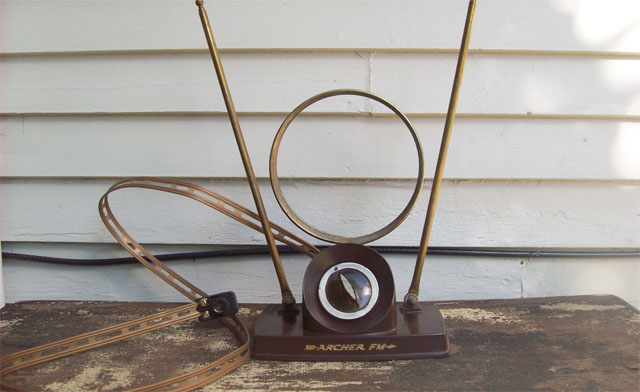
[http://www.technologytell.com/hometech/files/2013/08/rabbitears.jpg]
I first cut the cord on cable TV several years ago. More than a way to save money, it was a practical step, being a busy consultant flying over 100k miles a year. There was no point of subscribing when I was never home. It was 2009, and HDTV was available over-the-air (OTA) using conventional rabbit ear antennas (FCC, 2016). I was able to see all of the major broadcast networks (e.g, ABC, CBS, FOX, NBC) for free and in high definition. The problem was, when I did stop all the traveling and returned home, there was not much choice for premium TV content, except to sign up for TV packages from your local cable or satellite provider. If you wanted to watch content from HBO, Showtime, Cinemax, and Starz, it was an add-on to the TV package that you were already paying a premium for. Basically, you went free-but-limited, or you had to go all-in and pay for a subscription package (unless one chose to resort to illegal procurement).
Fast forward to 2016, and there is a growing variety of ways to get TV content. Some of the most popular formats are on the Apple TV and Amazon Fire TV platforms that support services such as Netflix and Hulu. There are add-ons to subscribe to streaming services and premium channels a la carte, and alternatives like DIRECTV and AT&T U-verse TV. However, the most compelling products have recently come from Sling TV and Sony’s PlayStation Vue (Brantner, 2016; Elliott, 2016; Pressman, 2016).
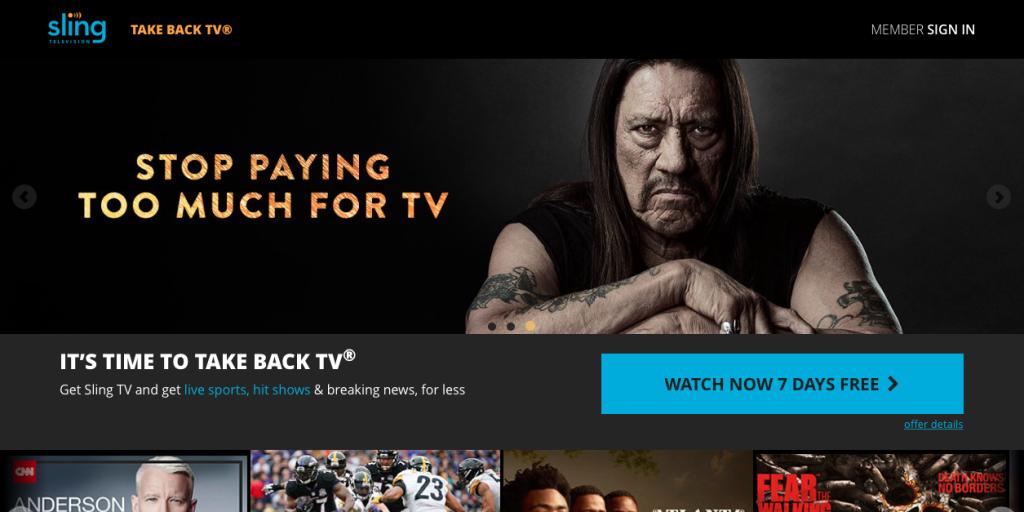
[from sling.com]
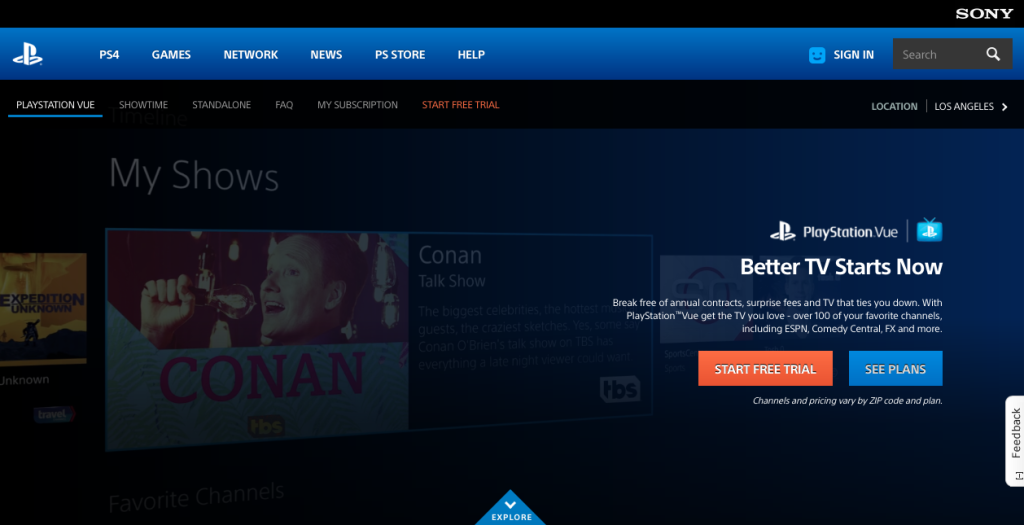 [from www.playstation.com/en-us/network/vue/]
[from www.playstation.com/en-us/network/vue/]
Where OTA broadcast TV, steaming entertainment, and pass-though apps (e.g., HBO GO, WatchESPN) fall short, the TV packages from Sling TV and PlayStation Vue pick up to offer live Internet TV, where you can choose an entertainment package within a tiered price point business model. Furthermore, both services offer cloud-based DVR and add-ons to access traditionally premium channels, the most notable being HBO (and Cinemax) coming to PlayStation Vue (Benefield, 2016) by October 2016.
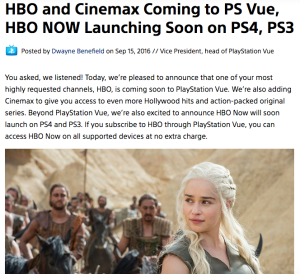
(Benefield, 2016)
Today, with family life, work, and school, my wife and I only watch a few select shows. Our TiVo/DVR backlog is huge and were never going to catch up anyhow. All we really want, are HBO (Game of Thrones), AMC (The Walking Dead), and ESPN (sports). (I’ve actually become disillusioned with ESPN, but that is for another blog post.) Having reattached the cord, I was looking at cutting it again. I was first made aware of PlayStation Vue through Facebook word-of-mouth from an old high school friend.
It was this word of mouth in my Facebook feed that got me interested. I began to investigate. I did what most consumers do today — Google and pour over reviews to the point of obsession. Here is a small sample from Amazon.com over the two products.
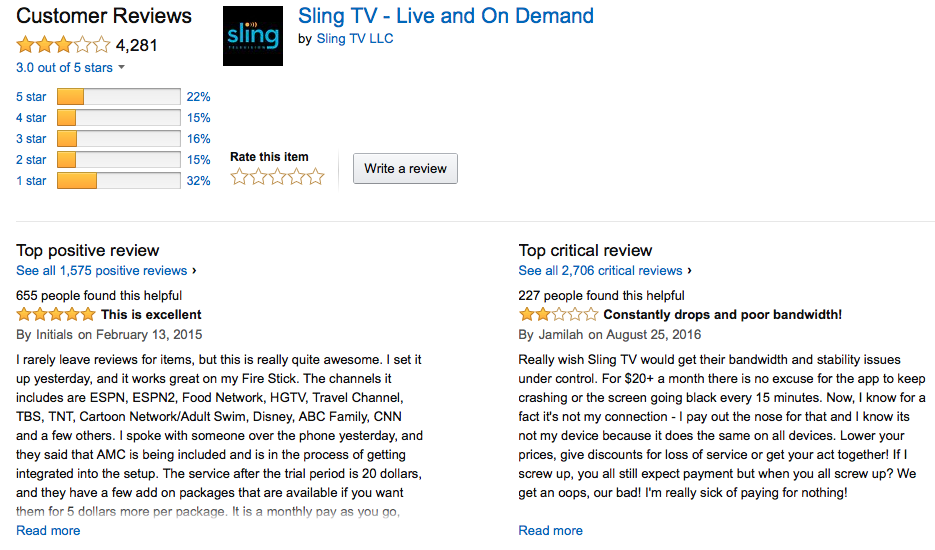
[from https://www.amazon.com/Sling-Television-Live-On-Demand/product-reviews/B00ODC5N80]
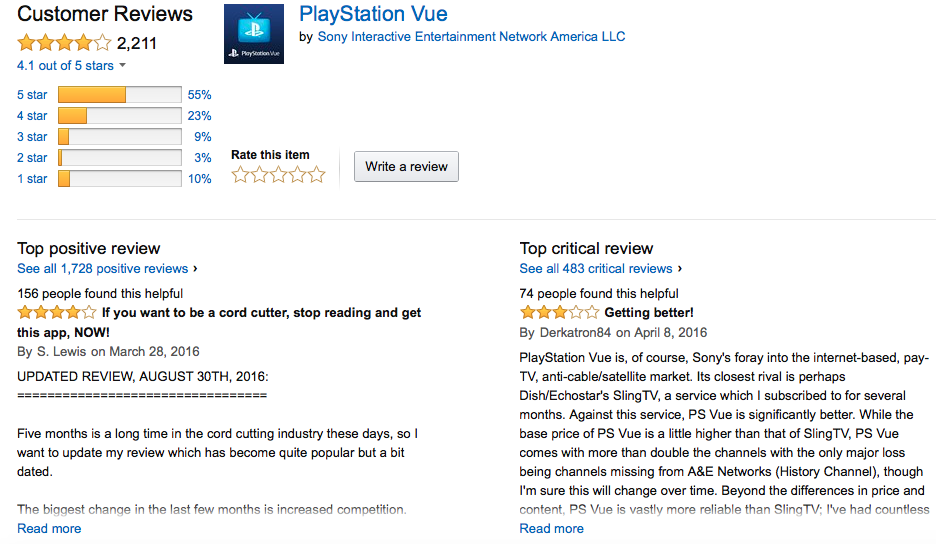
[from https://www.amazon.com/Sony-Network-Entertainment-PlayStation-Vue/product-reviews/B015TN9OQI?pageNumber=2]
It was clear that in this early stage, the reviews were mixed. The competing products were still working out the kinks. However, the early adopter in me decided it was worth trying out, and I went with the recommendation from my friend, which supports the research that Young (2014) presented on the most influential touch points on purchase. I took advantage of the 7-day trial period (both offered it). As I was explaining to my wife how I was cutting the cord, I saw skepticism on her face as she wondered how this would really work. She had never heard of PlayStation Vue or Sling TV, while I had been obsessing over it for the last couple of weeks!
It was a bit of a surprise to me that my wife had no knowledge of these products, but it turned out that she had been using the skip commercial feature of TiVo and had not seen one piece of marketing online or elsewhere for either PlayStation Vue or Sling TV. I, on the other hand, had been inundated with marketing communication, through social media ads and search content ads. As a sports fan at the start of football season, I saw many commercials online, especially during NFL broadcasts. The NFL is a big part of Internet TV provider strategies (Brantner, 2016; Elliott, 2016; Pressman, 2016).
Not all has been a TV utopia however. The rollouts of these products have been limited to a few select markets, and the bugs and kinks are real. As much as PlayStation Vue has seen early success, there has been frustration with the user experience from customers, judging from online reviews, Reddit, and the PS Vue support website. My own personal frustration with PlayStation Vue is that the user interface and experience ironically works best on Amazon Fire TV. I, as a PlayStation4 (game console) owner, thought that Sony would better integrate the Vue experience with their own hardware and platform. However, I believe that these issues with new Internet TV offerings will subside and the services will improve and mature.
Here are the two commercials that I remember most from these current campaigns:
Sling TV:
https://youtu.be/aUw8LBuvieA
PlayStation Vue:
https://youtu.be/RyLCj8DXOgE
For my household, so far so good, with PlayStation Vue. It’s not perfect, but with the choices we have in 2016, there’s nothing to lose and a lot of money to save. With the choices we now have, the future is looking up for Internet TV. Considering the inevitable licensing deals with content providers and networks, and new competition coming from Twitter and AT&T U-verse (Brantner, 2016; Elliott, 2016; Pressman, 2016), conventional cable and satellite providers have reason to rethink their strategies.
Questions:
How familiar are you with these products and services?
How would you market to someone like my wife (e.g., work-at-home-mom, mother of 1.5 and a dog, watches recordings in order to skip commercials?)
How would do you gather insight as a TV content provider?
Would you rather be an established giant, or an up-and-coming competitor in this space?

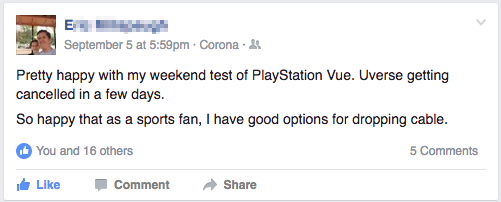
2 Responses to Cutting the Cord is Back and the Future is Bright – My Buyer Journey